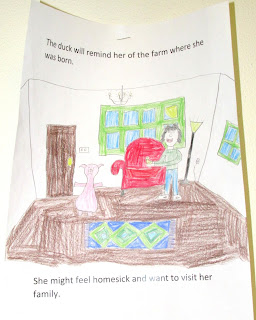As part of our Book Illustrator lesson plan, the 4th, 5th and 6th grade classes created illustrations of Laura Numeroff's well-loved children's books "If you..."
Each student was given one page of the story, with only the words as a guide.
I read each book out-loud, so they would understand the overall story-line.
I encouraged them to come up with their own ideas of how their part of the story would be illustrated. A few struggled with this, so after some time had passed, I allowed them to look at Felicia Bond's drawings in the book.
We talked about how her work is very detailed. There are a lot of little things that a person might notice that aren't mentioned in the text of the story. For instance, on the book cover, the little mouse is wearing overalls. It might cause the reader to wonder how he got such tiny clothes. ;)
Here are some of the pages that the 4th grade class illustrated for "If You Take a Mouse to School". The teachers of the three classes were kind enough to let me have some wall-space in their classrooms, so that we could display the kids' work.


The 5th graders illustrated "If You Give a Pig a Pancake".


One really great thing about this lesson was that for the student who works quickly and thinks they're "done" after 5 minutes, I was able to point out ways that they could add more detail. In the picture above, for instance, the student drew the pig at the table and said, "I'm done."
I asked him, "Where are the pancakes?" He added pancakes. "I'm done."
"What is the pig going to eat them with?"
So he drew the fork and knife.
Then we talked about other details that could be added, such as a clock on the wall.
Sixth Grade illustrated "If You Give a Mouse a Cookie".




Learning to be book illustrators was a really fun project for this age.
Unlike the 1st- 3rd graders' Eric Carle books, where they added color and texture to the already illustrated pages, the older kids had to imagine the story and draw their ideas,
based only on the written words. It's an easier task for someone who is a visual thinker, but it's good to challenge those that are not as natural at it.
Practice is key!


































